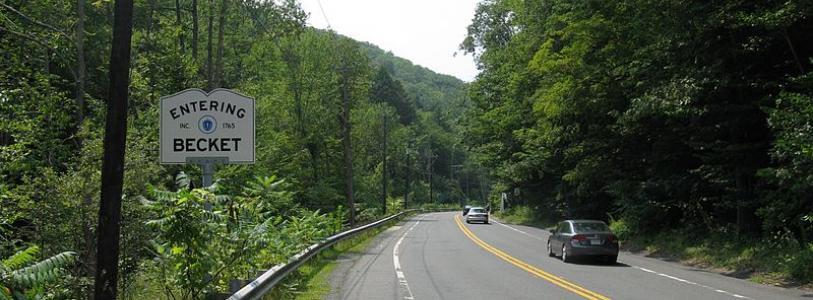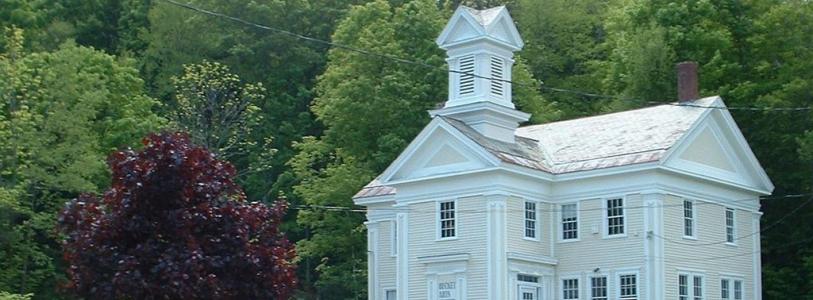Wireless Communications Bylaws
Full Wireless Communications By-Law (PDF)
I. Purpose
The purpose of this by-law is to outline the special permitting process to site a wireless communication facility within the Town of Becket, while minimizing potential damage and adverse visual impacts of wireless communication facilities on adjacent properties, residential neighborhoods, and areas of historic or high scenic value; to allow the provision of necessary wireless communication services in an orderly way; and to promote shared use of existing facilities which reduce the need for new facilities.
II. Definitions
- DISTANCE shall be measured on a horizontal plane.
- FAA shall mean the Federal Aviation Administration.
- FCC shall mean the Federal Communications Commission.
- HEIGHT shall be the distance measured from ground level to the highest point on the structure.
- NON-RESIDENTIAL STRUCTURE shall mean such structures as but not limited to buildings, grain silos, and water towers, but does not include houses or apartments.
- WIRELESS COMMUNICATION BUILDING shall mean any building or shelter used to house equipment primarily for generating and detecting electromagnetic radiation and is an accessory to a wireless communication structure.
- WIRELESS COMMUNICATION DEVICE shall mean any antenna, appurtenance, wiring or equipment used in connection with the reception or transmission of electromagnetic radiation which is attached to a structure.
- WIRELESS COMMUNICATION FACILITY shall be used as a general term to include wireless communication building, wireless communication device, and wireless communication structure.
- WIRELESS COMMUNICATION STRUCTURE shall mean any structure or tower intended to support equipment used for the transmission and reception of electromagnetic radiation, including the antennas, wiring or other devices attached to or mounted on a structure.
III. Exemptions
The following shall be exempt from this by-law:
- Wireless communication facilities used for Town or State emergency services.
- Amateur radio towers used in compliance with the terms of any amateur radio service licensed by the Federal Communications Commission and used solely for that purpose.
- Wireless communication structures and devices used expressly for home television and radio reception.
IV. General Guidelines
- No wireless communication facility shall be erected, constructed, or installed without a special permit from the Planning Board.
- Wherever feasible, wireless communication devices shall be located on existing towers or other non-residential structures, minimizing proliferation of new towers.
- Wireless communication structures shall be built so that the structural integrity of the facility is able to accommodate devices operated by another carrier with little or no modification.
- Wireless communication buildings shall be no larger than 500 square feet and 12 feet high, shall be designed to match other accessory buildings on site, and shall be used only for the housing of equipment related to this particular site.
- Any change in use of the structure must be pre-approved by the Planning Board.
V. Siting and Height Requirements
- Setbacks
- The minimum distance from the base of the wireless communication structure to any property line or road right-of-way shall be at least 1.25 times the height of the structure.
- The minimum distance from any guy wire, anchor or brace to any property line or road right-of-way shall be equal to the length of the guy wire.
- The setbacks for the wireless communication building shall comply with the setback requirements for the zoning district.
- The wireless communication structure shall be a minimum distance of three times the height from school buildings, including playgrounds and athletic fields, and abutting residences to prevent the structure from appearing to “tower” over, adversely affecting property values.
- The height shall be the minimum height necessary to accommodate anticipated and future use.
- Wireless communication structures are encouraged on State lands, provided that said lands are not subject to the provisions of Article 97 of the Amendments to the Constitution of the Commonwealth of Massachusetts. If facilities predating this by-law exist on such lands, the shared use of such facilities is encouraged.
- The wireless communication structure shall, when possible, be sited off ridge lines and where their visible impact is the least detrimental to valuable historic and scenic areas. “Valuable” should be determined by any appropriate Town Board(s) and can be views that the Town has identified as scenic or views listed in the Massachusetts Landscape Inventory. M.G.L. C.131, s. 39A, conducted by Massachusetts Dept. Of Environmental Management, 1982.
- No new wireless communication structure shall be permitted unless the Applicant demonstrates to the reasonable satisfaction of the Planning Board that no existing wireless communication structure can accommodate the Applicant’s proposed wireless communication device. Evidence submitted to demonstrate that an existing structure can not accommodate the applicant’s proposed device may consist of any of the following:
- No existing wireless communication structures or non-residential structures are located within the geographic area required to meet the Town of Becket and applicant’s engineering requirements.
- Existing wireless communication structures or non-residential structures are not sufficient height to meet the applicant’s requirements.
- Existing wireless communication structures or non-residential structures do not have sufficient structural strength or cannot be brought up to appropriate strength to support the proposed wireless communication device.
- The proposed wireless communication device would cause electromagnetic interference with the existing devices on the site, or the existing devices would cause interference with the proposed wireless communication device.
- The fee, costs, or contractual provisions required by the owner in order to share an existing wireless communication structure or to adapt an existing structure for use are unreasonable.
- The applicant demonstrates that there are other limiting factors that render existing structures unreasonable.
VI. Design Requirements
- Wireless communication structures shall be designed to accommodate the maximum number of users as technologically possible.
- There shall be no signs or advertisements, except for no trespassing signs and a required sign giving a phone number where the responsible party can be reached on a 24-hour basis.
- All wireless communication devices shall be colored, molded, and/or installed to blend into structure and/or the landscape.
- The facility shall be fenced to control access.
- Night lighting of the facility shall be prohibited unless required by the FAA. If required by FAA, a copy of the FAA permit requiring lighting should be submitted with the application.
- There shall be a maximum of one parking space at each facility to be used in connection with maintenance of the site and shall not be used for the storage of vehicles or other equipment.
- Existing on-site vegetation shall be preserved to the maximum extent possible.
- Vegetative screening shall be used to screen abutting residential properties and roadways. Plants that fit in with the surrounding natural vegetation shall be used.
VII. Application Process
Applications for a special permit for siting wireless communication facilities shall be filed in accordance with rules and regulations already established in the zoning by-law.
The Planning Board shall hold a public hearing within sixty-five days of filing of an application and shall issue a decision within ninety days following the date of the public hearing.
- TO SITE A NEW WIRELESS COMMUNICATION STRUCTURE, the Applicant shall submit:
- Site plans and engineering plans, prepared by a professional engineer licensed to practice in Massachusetts, on 24” x 36” sheets at a scale of 1”=40’ or 1”=200’, where appropriate, on as many sheets as necessary to show the following:
- north arrow, date, scale, seal(s) of the licensed professional(s) who prepared plans and space for the reviewing licensed engineer’s seal.
- name and address of landowner and name and address of abutters.
- property lines and location of permanent structures or buildings within 500-foot radius of proposed wireless communication structure.
- existing (from a topographical survey completed within 2 years of application submittal date by a professional surveyor licensed to practice in Massachusetts) and proposed contours at a maximum of 2-foot intervals and spot elevations at the base of all the proposed and existing structures.
- vegetation to be removed or altered.
- plans for drainage of surface water and plans to control erosion and sedimentation, both during construction and as a permanent measure.
- delineation of wetlands, if any.
- location of wireless communication structure, including supports or guy wires, if any.
- plans for anchoring and supporting the structure, including specifications of hardware and all other building material.
- plans for accessory buildings.
- layout and details of surfacing for access road and parking.
- amenities such as lighting, fencing, landscaping.
- four view lines in a one to three-mile radius of the site, beginning at True North and continuing clockwise at ninety-degree intervals and additional view lines from any historic, scenic, or other prominent areas of Town determined by the Planning Board.
- plans for a well or other water source, if any..
- plans for any septic system, if any.
- plans for maintenance of roads necessary to access and maintain the property.
- A map showing areas covered/served by the proposed wireless communication structure and device of different signal strengths, and the interface with adjacent service areas.
- A locus map at a scale 1”=1000’ which shall show streets, buildings, and landscape features.
- A description of the soil and surficial geology at the proposed site.
- A narrative report written by the carrier and licensed professional engineer which shall:
- Describe the justification of proposed site.
- Describe the structure and the technical, economic, and other reasons for the facility design.
- Describe the capacity of the structure, including the number and the type of additional facilities it can accommodate.
- Describe actions to be taken if electromagnetic radiation from the facility should exceed levels designated by the FCC.
- Describe the projected future needs of the carrier, and how the proposed wireless communications facilities fit with the future projections to serve the Town and adjacent towns.
- Describe leasing agreement should another carrier desire to co-locate.
- Describe special design features to minimize the visual impact of the proposed wireless communication facility.
- Describe in detail the steps which the carrier will follow in the event of an emergency, such as fire or collapse of the tower. In particular, what are the responsibilities of the carrier and how are the town officials to be notified for the safety of personnel, town and personal properties?
- Proof of approval of all other necessary permits needed for construction and operation.
- If the proposed facility is taller than zone height restriction, after the application is submitted, and not more than 14 days before the public hearing, the applicant shall arrange to fly a two-foot-diameter balloon at the site of the proposed wireless communication structure at the maximum height of the proposed installation. The date and location of the flight shall be advertised at least 14 days, but not more than 21 days before the flights, and again in the public hearing advertisement in a newspaper with a general circulation in the town.
- Site plans and engineering plans, prepared by a professional engineer licensed to practice in Massachusetts, on 24” x 36” sheets at a scale of 1”=40’ or 1”=200’, where appropriate, on as many sheets as necessary to show the following:
- TO SITE A WIRELESS COMMUNICATION DEVICE ON EXISTING WIRELESS COMMUNICATION STRUCTURES OR NON-RESIDENTIAL STRUCTURES, such as buildings, grain silos, steeples, water towers or other non-residential structures, including co-location with another carrier, provided that the new use does not add to the height of the structure, the Applicant shall submit:
- Site plans and engineering plans, prepared by a professional engineer licensed to practice in Massachusetts, on 24” x 36” sheets at a scale of 1”=40’ or 1”=200’ on as many sheets as necessary which show the following:
- north arrow, date, scale, the seal(s) of the licensed professional(s) who prepared the plans and a space for the reviewing licensed engineer’s seal.
- plans for supporting and attaching the device, including specifications of hardware and all other building material.
- building plans for accessory buildings, if any.
- layout and details of surfacing for access road and parking, if it is to be altered from existing condition.
- A map showing the areas covered by proposed device(s) of different signal strengths and the interface with adjacent service areas.
- A narrative report written by the carrier and licensed professional engineer which shall:
- include a draft of the contract between the structure/building owner (whichever appropriate) and the Applicant.
- demonstrate that the wireless communication structure or non-residential structure to which the device will be mounted has the structural integrity to support such a device.
- describe actions to be taken if electromagnetic radiation from the facility should exceed levels designated by the FCC.
- describe the projected future needs of the carrier and how the proposed facility fits with future projections.
- describe in detail the steps which the carrier will follow in the event of an emergency, such as fire or collapse of the tower. In particular, what are the responsibilities of the carrier and how are the town officials to be notified for the safety of personnel, town and personal properties?
- Proof of approval of all other permits needed for construction and operation.
- If the proposed facility adds more than five feet to the height of the structure at the effective date of this by-law and will exceed zone height restrictions, the Planning Board may require a balloon test as described above in VII.,A.,7.
- Site plans and engineering plans, prepared by a professional engineer licensed to practice in Massachusetts, on 24” x 36” sheets at a scale of 1”=40’ or 1”=200’ on as many sheets as necessary which show the following:
- 12 copies of the above information shall be submitted along with the application form to the Planning Board.
VIII. Approval
- In granting a special permit for wireless communication facilities, in addition to the findings required by the Town’s Zoning By-Law for Special Permits, the Town of Becket Planning Board shall find:
- That the Applicant has demonstrated to the satisfaction of the Planning Board that the requirements of this by-law have been met.
- That the size and height of the structure is the minimum necessary.
- That the proposed wireless communication facilities will not adversely impact historic structures or scenic views.
- That there are no feasible alternatives to the location of the proposed wireless communication facilities, including co-location, that would minimize their impact, and the applicant has exercised good faith in permitting future co-location of facilities at the site.
- When considering an application for wireless communication facility, the Planning Board shall place great emphasis on the proximity of the facility to residential dwellings, its impact on these residences, and will encourage the use of existing structures.
- Any extension or construction of new or replacement towers or transmitters shall be subject to the Special Permit, following the same procedure as siting a new wireless communication device.
IX. Conditions of Use
- An initial bond shall be posted by the applicant to cover construction costs and removal cost of facility in the event of non use and an annual maintenance bond for the access road, site, and structure(s) in an amount approved by the Planning Board. An access road may include existing town roads not designed for heavy traffic and which are not paved.
- Regulatory Compliance
- Annual certification demonstrating structural integrity and continuing compliance with current standards of the FCC, FAA and the American National Standards Institute shall be filed with the Building Inspector by the Special Permit Holder, and shall be reviewed by a licensed professional engineer hired by the town and paid for by the Special Permit Holder.
- If the FCC or the FAA regulations are changed, the owner or operator shall bring the facilities into compliance within six months or earlier if a more stringent compliance schedule is included in the regulation.
- Failure to comply with any regulations shall be grounds for removal of non-complying structures, buildings, and devices at the owner’s expense.
- Removal and Repair
- An applicant must either file a performance bond or a deposit of money or negotiable securities in an amount determined by the Board to be sufficient to cover the cost of removal with the Town of Becket Planning Board agreeing to remove, within 180 days of notice from the town, the wireless communication facility not in operation for a period of twelve months, unless the reason for non-operation is the result of major damage. The Board may hire professional consultants to determine the amount of bond or security required. Such bond or security, if filed and deposited, shall be approved as to form and manner of execution by Town Counsel, and shall be contingent on the completion of repairs or removal.
- If the facility is not removed within 180 days, the Town will remove said facility at the owner’s expense.
- In the event of major damage, repair must begin immediately or as soon as possible. Major damage shall mean damage to the facility caused by no fault of the owner or operator.




